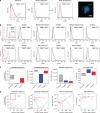Maternal and infant infections stimulate a rapid leukocyte response in breastmilk
- PMID: 25505951
- PMCID: PMC4232055
- DOI: 10.1038/cti.2013.1
Maternal and infant infections stimulate a rapid leukocyte response in breastmilk
Abstract
Breastmilk protects infants against infections; however, specific responses of breastmilk immune factors to different infections of either the mother or the infant are not well understood. Here, we examined the baseline range of breastmilk leukocytes and immunomodulatory biomolecules in healthy mother/infant dyads and how they are influenced by infections of the dyad. Consistent with a greater immunological need in the early postpartum period, colostrum contained considerable numbers of leukocytes (13-70% out of total cells) and high levels of immunoglobulins and lactoferrin. Within the first 1-2 weeks postpartum, leukocyte numbers decreased significantly to a low baseline level in mature breastmilk (0-2%) (P<0.001). This baseline level was maintained throughout lactation unless the mother and/or her infant became infected, when leukocyte numbers significantly increased up to 94% leukocytes out of total cells (P<0.001). Upon recovery from the infection, baseline values were restored. The strong leukocyte response to infection was accompanied by a more variable humoral immune response. Exclusive breastfeeding was associated with a greater baseline level of leukocytes in mature breastmilk. Collectively, our results suggest a strong association between the health status of the mother/infant dyad and breastmilk leukocyte levels. This could be used as a diagnostic tool for assessment of the health status of the lactating breast as well as the breastfeeding mother and infant.
Keywords: breastfeeding; breastmilk; immune; immunoglobulin; infection; leukocyte.
Figures




References
-
- Perez PF, Dore J, Leclerc M, Levenez F, Benyacoub J, Serrant P, et al. Bacterial imprinting of the neonatal immune system: lessons from maternal cells. Pediatrics. 2007;119:e724–e732. - PubMed
-
- Le Huerou-Luron I, Blat S, Boudry G. Breast-v. formula-feeding: impacts on the digestive tract and immediate and long-term health effects. Nutr Res Rev. 2010;23:23–36. - PubMed
-
- Walker WA. The dynamic effects of breastfeeding on intestinal development and host defense. Adv Exp Med Biol. 2004;554:155–170. - PubMed
LinkOut - more resources
Full Text Sources
Other Literature Sources
